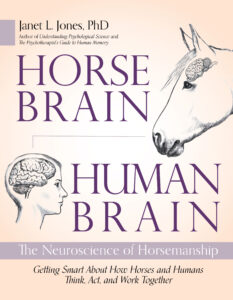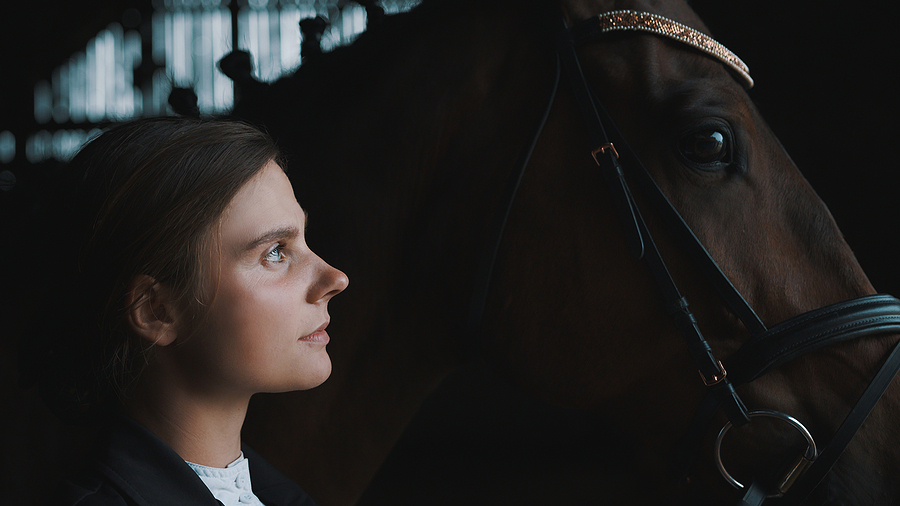Horses and humans have been partners for some 6,000 years. What makes us a good team? One reason is that our brains work in complementary ways. Understanding how horses think and how your own brain works is key to developing a strong relationship.
If you love horses, ride, work with horses in any way, or simply have an interest in animal behavior, “Horse Brain, Human Brain” by Janet L. Jones, Ph.D., is the book for you. I was a bit skeptical, thinking this could be a dry, academic tome, but it is not. It is an enjoyable read and broken up into sections so that if you have only 5 or 10 minutes at a time to dip into it, you can still gain some insights.

Dr. Jones is a neuro/cognitive scientist (think brain researcher) but along with her academic work has trained horses and riders to upper levels in many disciplines from hunter to reining. She has “street cred” for both human and equine brain functions.
The initial part of the book is worth its price all alone. Dr. Jones breaks down equine senses and the anatomical differences between human and equine brains. The drawings are simple but valuable, showing how much of their brain horses devote to sight, smell, and hearing. We are continually reminded that horses are prey species – designed for fast, reflexive flight, while humans are predators (at least from an equine point of view).
While discussing the senses, the author provides simple exercises to demonstrate how differently a horse sees the world. For example, watch a class of open jumpers. First, consider depth perception – horses are way behind us in this skill. Throw in the fact that horses ideally need about 45 minutes to totally adjust when going from a dark to light area or vice versa. It is amazing that horses can safely and skillfully take jumps with the need to adjust on the fly.
At the same time, horses are superb at picking up even small peripheral motions such as that falling leaf that led to a major spook. You thought there was no reason, but your horse picked up a possible predator movement.
While humans are visually oriented, horses rely more on scent and hearing. Humans are lousy at smell, but horses are superb. You might not notice anything, but your horse will pick up the scent of a male coyote who trotted down the bridle path two hours ago. (As an aside, there are now horses being trained for search and rescue. While they aren’t quite the sniffing geniuses that dogs are, horses can cover a lot of ground quickly out in open country.)
Horses will also make associations with smells. Ideally, your scent is a positive one, but the farrier or veterinarian may present a less positive odor to your horse. My Arabian was gelded when he was five years old, shortly before we got him. Clearly Monte associated the scent of alcohol used before being given an intravenous injection, which led to less than pleasant things. If you tried to wet his hair with alcohol for a simple blood draw you dealt with a berserk horse. Switch to clear water, and he was a calm equine citizen. That lasted until his death when he was 30 years old.
The second half of the book takes what is known about equine anatomy, senses, and cognition to help readers better train and relate to their horses. Included are exercises to help humans hone their own senses, such as proprioception. These exercises, along with being cognizant of a horse’s corresponding senses, can help them be better handlers and riders, as well as true horsepersons.
Dr. Jones also addresses equine social life. Horses are herd animals. It has been shown that horses can learn to some extent by watching another horse. Let your trailer-fearing mare watch her solid gelding friend load into the trailer four or five times. Maybe even sit on this overnight and let her watch again the next day. Many horses will follow the example set for them, showing that it is safe to get in a trailer (definitely not a natural behavior for a horse or what would appear to be a “safe” space.)
I think this is an excellent book for any horse fancier or person who works with horses to read and refer to again and again. Understanding the horse’s perspective can help you adjust how you train or do procedures as well as assist in planning for the best, least stressful care.
This article was reviewed/edited by board-certified veterinary behaviorist Dr. Kenneth Martin and/or veterinary technician specialist in behavior Debbie Martin, LVT.








